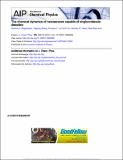The chemical dynamics of nanosensors capable of single-molecule detection
Author(s)
Boghossian, Ardemis A.; Zhang, Jingqing; Le Floch-Yin, Francois T.; Ulissi, Zachary Ward; Bojo, Peter; Han, Jae-Hee; Kim, Jong-Ho; Arkalgud, Jyoti R.; Reuel, Nigel Forest; Braatz, Richard D.; Strano, Michael S.; ... Show more Show less
DownloadBraatz_Chemical dynamics.pdf (896.8Kb)
PUBLISHER_POLICY
Publisher Policy
Article is made available in accordance with the publisher's policy and may be subject to US copyright law. Please refer to the publisher's site for terms of use.
Terms of use
Metadata
Show full item recordAbstract
Recent advances in nanotechnology have produced the first sensor transducers capable of resolving the adsorption and desorption of single molecules. Examples include near infrared fluorescent single-walled carbon nanotubes that report single-molecule binding via stochastic quenching. A central question for the theory of such sensors is how to analyze stochastic adsorption events and extract the local concentration or flux of the analyte near the sensor. In this work, we compare algorithms of varying complexity for accomplishing this by first constructing a kinetic Monte Carlo model of molecular binding and unbinding to the sensor substrate and simulating the dynamics over wide ranges of forward and reverse rate constants. Methods involving single-site probability calculations, first and second moment analysis, and birth-and-death population modeling are compared for their accuracy in reconstructing model parameters in the presence and absence of noise over a large dynamic range. Overall, birth-and-death population modeling was the most robust in recovering the forward rate constants, with the first and second order moment analysis very efficient when the forward rate is large (>10[superscript −3] s[superscript −1]). The precision decreases with increasing noise, which we show masks the existence of underlying states. Precision is also diminished with very large forward rate constants, since the sensor surface quickly and persistently saturates.
Date issued
2011-08Department
Massachusetts Institute of Technology. Department of Aeronautics and Astronautics; Massachusetts Institute of Technology. Department of Biological Engineering; Massachusetts Institute of Technology. Department of Chemical EngineeringJournal
Journal of Chemical Physics
Publisher
American Institute of Physics (AIP)
Citation
Boghossian, Ardemis A. et al. “The Chemical Dynamics of Nanosensors Capable of Single-molecule Detection.” The Journal of Chemical Physics 135.8 (2011): 084124. ©2011 American Institute of Physics
Version: Final published version
ISSN
0021-9606
1089-7690